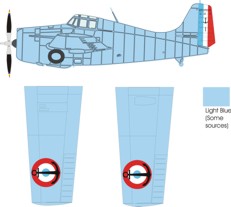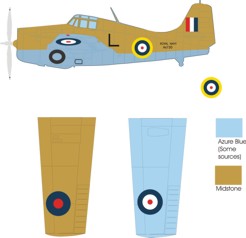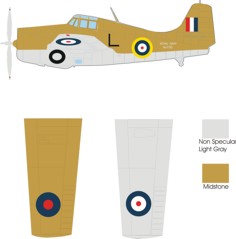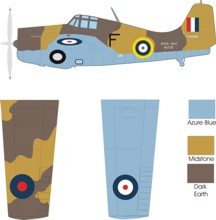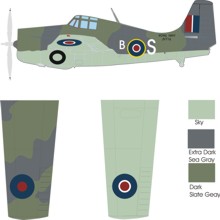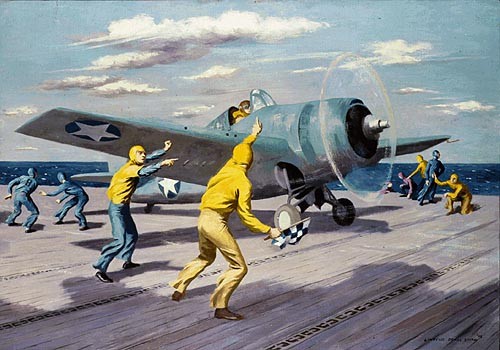 |
( "To The Attack!" by
Lawrence Beall-Smith 1943)
When the Wildcat entered service in
late 1940 it was near the end of the United States Navy's
pre-war colorful era era. By the time it passed out of
service in the immediate post-war era the standard color
scheme carried by navy aircraft was overall Gloss Sea
Blue. Few other WWII era aircraft carried as many
colors and the evolution of Wildcat camouflage is a
good illustration of USN camouflage.
On this page I will try to touch on every camouflage
scheme used on the Grumman F4F Wildcat/Martlet.
F4F-3 and F4F-4 Wildcats
The Grumman F4F-3 Wildcat
entered service in the last days of 1940, this was as
the colorful era of Naval Aviation was coming to a
close. As delivered from the factory, the Wildcat
was finished in painted aluminum with Yellow Orange
upper wings, often referred to as "Chrome Yellow". The
yellow actually slightly wrapped around onto the lower
wing. Only two airwings received aircraft painted in
this scheme before an overall light gray was
substituted. Those airwings were Airwing Four aboard
the USS Ranger (VF-41 & VF-42) and
Airwing Seven aboard the USS Wasp (VF-71 & VF-72). The Ranger's aircraft sported
Willow Green tails and the Wasp's
carried Black. With this scheme the national insignia
was on both sides of the fuselage and on the top and bottom
of both wings. The squadron, mission and aircraft
number were carried on the fuselage as they had been for
many years. In the case of the F4F below that would be
"41-F-7", which would translate to the number seven aircraft
of VF-41. This was also a section leader's aircraft,
so the full cowl ring was painted in the section color as
was the fuselage band.
In late
December, 1940 shipboard aircraft were ordered painted non-specular light
gray. This color would later become Light Gray
ANA 602 and under the FS595B standards the closest would be
Light Gull Gray 36440. Light gray was a "neutral"
gray, meaning pure gray, while gull gray has a slight tan
tint. There was some variation to the national emblem, but
not as much as would come with the Blue Gray over Light Gray
scheme that replaced the overall gray scheme. Some
aircraft carried a small insignia forward of the tail
planes, while others had a larger one slightly forward of
that position. With this change the national insignia
was reduced to four positions: Both sides of the
fuselage, the top left and bottom right wings. The
alpha-numeric codes were to remain for some time.
In
the summer of 1941 Blue Gray was painted over the upper
surfaces, leaving the lower surfaces in Light Gray. Blue
Gray had no ANA number and seemed to vary in shade. In
most cases painting was done aboard ship resulting in some
inconsistencies. A good example would be the F4F-3
Wildcats delivered to VMF-211 on Wake Island. Those
aircraft were painted while aboard the USS Enterprise
while she and the Saratoga were delivering them to
Wake. The Blue Gray was brought up short of the cowl
ring, leaving the Light Gray all the way to the top.
They also retained the four position national emblems.
Almost immediately it was determined that this was not enough and on
most Wildcats the size increased again, with VF-41's F4F-4s
being a good example.
VF-6
aboard the Enterprise took this to an extreme; enlarging the
fuselage insignia and moving it forward and enlarging the
wing insignia and moving it outboard. Upon occasion the former insignia would
protrude from underneath the new.
All of
the above changes were made in haste and carried out as
operations permitted. On item of concern was the red
dot inside the star appeared to be a Japanese Hinomaru to some
pilots resulting in Allied pilots mistaking American
planes for Japanese. The rudder stripes were also felt
to compromise an otherwise good camouflage scheme, so on May
6, 1942 the red "dot" and rudder stripes were dispensed
with. (This was too late for the aircraft aboard the Yorktown
and Lexington, so the airwings aboard those
carriers still had the "dot" and rudder stripes during the
Battle of Coral Sea.) The six position insignia
was to remain. Some aircraft showed obvious signs of
this repainting, with the fresh color on the rudder being
obvious. Some variations in the location of the
national emblem would remain.

